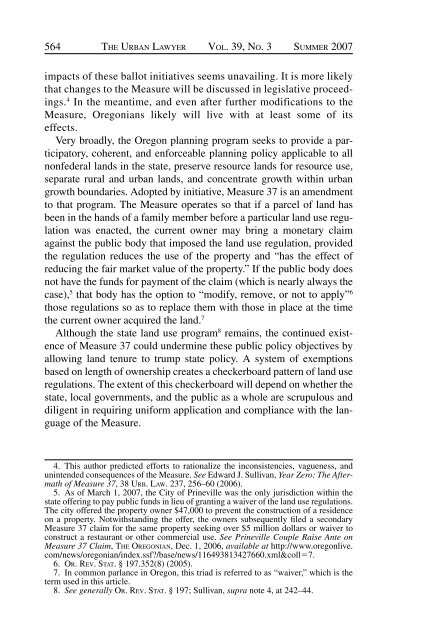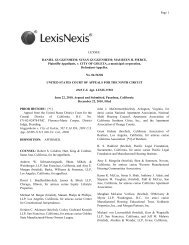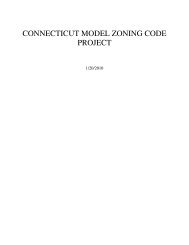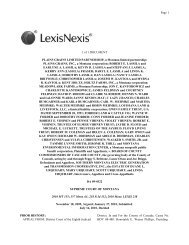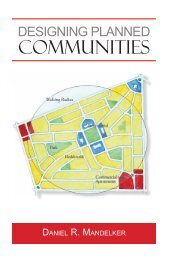Through a Glass Darkly: Measuring Loss Under ... - Land Use Law
Through a Glass Darkly: Measuring Loss Under ... - Land Use Law
Through a Glass Darkly: Measuring Loss Under ... - Land Use Law
You also want an ePaper? Increase the reach of your titles
YUMPU automatically turns print PDFs into web optimized ePapers that Google loves.
564 THE URBAN LAWYER VOL. 39, NO. 3 SUMMER 2007<br />
impacts of these ballot initiatives seems unavailing. It is more likely<br />
that changes to the Measure will be discussed in legislative proceedings.<br />
4 In the meantime, and even after further modifications to the<br />
Measure, Oregonians likely will live with at least some of its<br />
effects.<br />
Very broadly, the Oregon planning program seeks to provide a participatory,<br />
coherent, and enforceable planning policy applicable to all<br />
nonfederal lands in the state, preserve resource lands for resource use,<br />
separate rural and urban lands, and concentrate growth within urban<br />
growth boundaries. Adopted by initiative, Measure 37 is an amendment<br />
to that program. The Measure operates so that if a parcel of land has<br />
been in the hands of a family member before a particular land use regulation<br />
was enacted, the current owner may bring a monetary claim<br />
against the public body that imposed the land use regulation, provided<br />
the regulation reduces the use of the property and “has the effect of<br />
reducing the fair market value of the property.” If the public body does<br />
not have the funds for payment of the claim (which is nearly always the<br />
case), 5 that body has the option to “modify, remove, or not to apply” 6<br />
those regulations so as to replace them with those in place at the time<br />
the current owner acquired the land. 7<br />
Although the state land use program 8 remains, the continued existence<br />
of Measure 37 could undermine these public policy objectives by<br />
allowing land tenure to trump state policy. A system of exemptions<br />
based on length of ownership creates a checkerboard pattern of land use<br />
regulations. The extent of this checkerboard will depend on whether the<br />
state, local governments, and the public as a whole are scrupulous and<br />
diligent in requiring uniform application and compliance with the language<br />
of the Measure.<br />
4. This author predicted efforts to rationalize the inconsistencies, vagueness, and<br />
unintended consequences of the Measure. See Edward J. Sullivan, Year Zero: The Aftermath<br />
of Measure 37, 38 URB. LAW. 237, 256–60 (2006).<br />
5. As of March 1, 2007, the City of Prineville was the only jurisdiction within the<br />
state offering to pay public funds in lieu of granting a waiver of the land use regulations.<br />
The city offered the property owner $47,000 to prevent the construction of a residence<br />
on a property. Notwithstanding the offer, the owners subsequently filed a secondary<br />
Measure 37 claim for the same property seeking over $5 million dollars or waiver to<br />
construct a restaurant or other commercial use. See Prineville Couple Raise Ante on<br />
Measure 37 Claim, THE OREGONIAN, Dec. 1, 2006, available at http://www.oregonlive.<br />
com/news/oregonian/index.ssf/base/news/116493813427660.xml&coll7.<br />
6. OR. REV. STAT. § 197.352(8) (2005).<br />
7. In common parlance in Oregon, this triad is referred to as “waiver,” which is the<br />
term used in this article.<br />
8. See generally OR. REV. STAT. § 197; Sullivan, supra note 4, at 242–44.<br />
ABA-TUL-07-0701-Sullivan.indd 564<br />
9/18/07 10:43:37 AM


